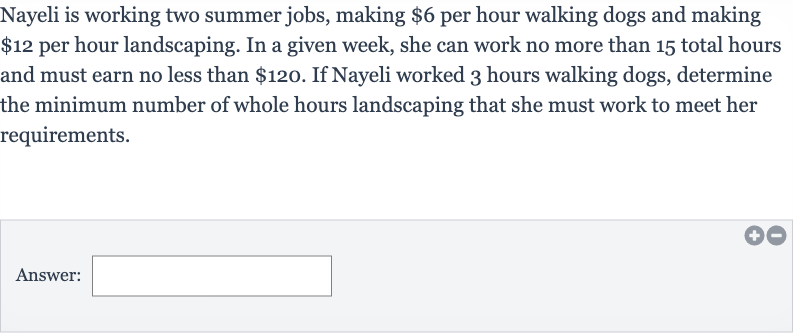AI tutor
Welcome to Bytelearn!
Let’s check out your problem:

Nayeli is working two summer jobs, making per hour walking dogs and making per hour landscaping. In a given week, she can work no more than total hours and must earn no less than . If Nayeli worked hours walking dogs, determine the minimum number of whole hours landscaping that she must work to meet her requirements.Answer:
Full solution
Q. Nayeli is working two summer jobs, making per hour walking dogs and making per hour landscaping. In a given week, she can work no more than total hours and must earn no less than . If Nayeli worked hours walking dogs, determine the minimum number of whole hours landscaping that she must work to meet her requirements.Answer:
- Calculate Dog Walking Earnings: First, we need to calculate the amount Nayeli earns from walking dogs for hours.She makes per hour walking dogs.So, hours of dog walking would earn her hours * /hour = .
- Subtract Dog Walking Earnings: Next, we need to subtract the amount earned from walking dogs from the total amount she needs to earn, which is .. Nayeli needs to earn at least from landscaping to meet her earnings requirement.
- Calculate Landscaping Hours: Now, we calculate the number of hours she needs to work landscaping to earn . She makes per hour landscaping. So, the number of hours needed is hours. Since she cannot work half hours, we round up to the nearest whole hour.
- Check Total Hours Worked: Nayeli must work at least whole hours landscaping to meet her earnings requirement.However, we must also ensure that the total hours worked in both jobs do not exceed hours.
- Check Total Hours Worked: Nayeli must work at least whole hours landscaping to meet her earnings requirement.However, we must also ensure that the total hours worked in both jobs do not exceed hours.We add the hours worked walking dogs to the hours needed for landscaping to check if it exceeds the -hour limit. hours (dog walking) + hours (landscaping) = hours.This does not exceed the -hour limit, so it is a valid solution.
More problems from GCF and LCM: word problems
QuestionGet tutor help
QuestionGet tutor help
